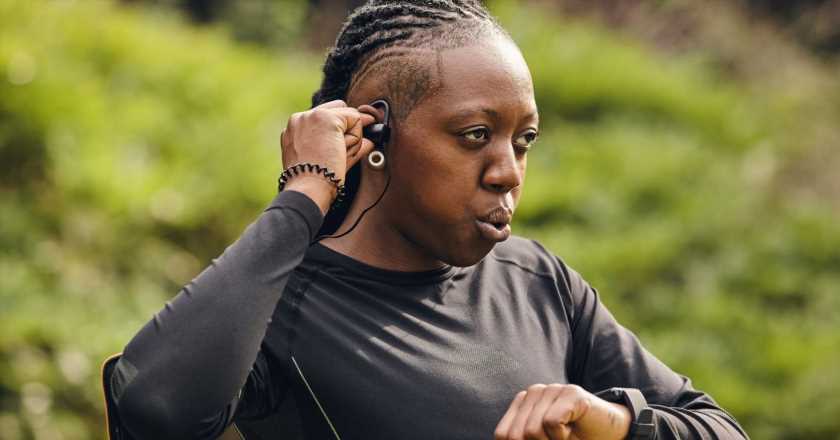Why shutting your mouth can make you a faster, stronger runner
If you want to run easier, faster and longer, you might be wondering about switching to nasal breathing. We explore whether we should shut up to keep up.
When I first started to run as a teenager, my dad gave me two instructions: “Don’t stop, however slowly you go,” and “Shut your mouth.” In those early days, I was gasping for air as I tried (and failed) to keep up with him, spitting every few metres and feeling super out of puff.
Eventually, I couldn’t bear his nagging anymore and concentrated on running slower with my mouth closed – sucking in air through my nostrils and only opening my mouth towards the end as we ramped up towards a sprint finish.
You may also like
Running technique: can running on your toes really make you faster?
That was over 15 years ago and those are still two of the best pieces of running advice I’ve come across. Nasal breathing, in my experience, allows you to pace better, use energy more efficiently and reduces the chances of swallowing midges (the pain is real, particularly around this time of year). And when you’re really struggling (if you’re going uphill or finishing with a sprint, for example), opening your mouth to breathe can feel like you’ve got a battery pack strapped to your back.
But just how much evidence is there to suggest that mouth breathing on a run has a negative impact on performance, and should those who struggle to keep their lips zipped persevere or give into nature?
Why does mouth breathing get such a bad rap?
For a start, mouth breathing has got a lot of bad press for health generally. A 2010 paper published by the Academy of General Dentistry suggested that “mouth breathing can cause poor oxygen concentration in the bloodstream, which can cause high blood pressure, heart problems, sleep apnea and other medical issues”. The nose also produces nitric oxide (NO), a chemical that improves our lungs’ ability to absorb oxygen (pretty useful when you’re running and using up oxygen at an increased rate).
Nasal breathing may be more effective for running
“As with much of running training, there is a huge amount of research and much that is contradictory,” says running coach Fiona English. “As a coach, the thing I focus on is heart rate, which if you don’t have the metrics to track it, could also be described as ‘running on feel’. This is a more practical way for runners to feel the difference between nasal breathing and mouth breathing. Running at a lower heart rate effort (also linked to nasal breathing) will enable runners to run further for longer.”
There are plenty of studies to suggest that nasal breathing can equal greater efficiency. One, published in the International Journal Of Kinesiology & Sport, looked at the effects of nasal versus oral breathing on VO2 max in recreational runners. It found that, regardless of intensity, runners could use nasal breathing without compromising their VO2 max, and with a little training, they actually had superior physiological economy.
A 2017 study, however, came to a slightly different conclusion. After making a group of runners do a series of high-intensity anaerobic intervals, scientists found that nasal breathing resulted in participants having an elevated heart rate – indicating an increased level of cardiovascular stress. The researchers concluded that, as power and performance output wasn’t affected by breathing mode during short bursts of intense exercise, it should be up to the individual to determine how they breathe.
Ultimately, it depends on the type of running
But when I ask if English tries to encourage her own clients to close their mouths, she says that it depends what they’re training for. If someone’s doing a track session on a hot day, then running 400m reps in the heat is going to be at best unpleasant and at worse, impossible, she says. “However, if you want to train for an ultramarathon or run a race in a colder temperature, there are huge benefits to keeping your heart rate lower and keeping yourself at an active ‘chat pace’.”
That chat pace, she says, is determined by how many answers people can give to simple questions. Being able to provide five or six-word answers to a question suggests that you’re nasally breathing, and “this will enable people to run for longer, while keeping their heart rate steady”.
You may also like
Running tips: 4 ways strength training makes you a better, faster runner
If you’re the kind of runner who just wants to be able to go out for a jog without feeling like you’re slogging yourself on the pavement, nasal breathing might make a big difference – especially if you want to run longer. I can’t remember how I did it, but I suspect my dad got me running 100m with my mouth closed and helped me to extend until I was running for 30 minutes like that.
English recommends: “Focus less on the extremes and more on effort. Try slowing down your runs and when you come across anything that causes additional effort like a hill, that sprint for the traffic lights you’d usually do, feeling stressed, tiredness, warmer weather, cut your effort back even further. If this means adopting a run-walk strategy, that’s OK.”
She also suggests incorporating more speed work into your training week to see your VO2 max and aerobic capacity increase. “This will, in turn, help your easy runs feel easy and reduce your need to grasp for air.”
For more running ideas, visit the Strong Women Training Club.
Images: Getty
Source: Read Full Article
